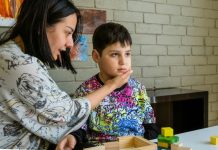
In a new study, researchers from over 50 centers around the globe found 102 genes linked to ASD—including many new ones that had not been recognized before.
Some of the genes are also linked to intellectual disabilities and developmental delays. But others are unique to autism and appear related to the social difficulties that mark the disorder.
It is the largest genetic study of the condition to date.
The research was conducted by a team at the Seaver Autism Center for Research and Treatment at Mount Sinai and elsewhere.
Autism is a brain disorder that affects social skills, communication and behavior control. In the United States, it affects one in 59 children, according to the U.S. Centers for Disease Control and Prevention.
The disorder is complex and varies widely from one person to the next.
Some children have milder problems with socializing and communicating, while others are profoundly affected—speaking little, if at all, and getting wrapped up in repetitive, obsessive behaviors.
Some children with autism have intellectual disabilities, while others have average or above-average IQs.
Researchers have long believed that a combination of genetic susceptibility and environmental exposures conspire to cause ASD—but genes are the bigger factor.
A recent study, of about 2 million people, estimated that genes account for 80% of the risk of autism. But the precise genes will vary among individuals.
In the new study, the team analyzed data from over 35,000 people, including nearly 12,000 with autism; the rests were their parents, unaffected siblings or other individuals without autism.
Using newer analytic techniques, the researchers were able to zero in on 102 genes associated with ASD.
Most risk genes are active early in brain development and have roles in regulating the activity of other genes or communication among brain cells.
The risk genes are also active in both “excitatory” and “inhibitory” neurons (nerve cells). This means that autism is not only related to one major type of brain cell but also involves “many disruptions” in brain cell function.
The team hopes their findings could eventually lead to new therapies. These pathways are important for finding new targets for treatment and more personalized health care.
The lead author of the study is Joseph Buxbaum.
The study is published in Cell.
Copyright © 2019 Knowridge Science Report. All rights reserved.



